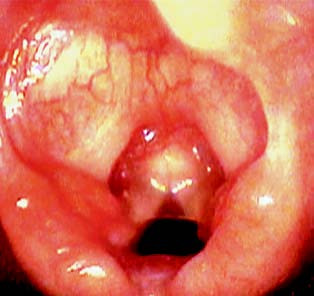Congenital laryngeal web is caused by abnormal embryonic development. By the 10th week of human embryonic development, when the embryo is approximately 30 mm in length, epithelial tissue derived from the closure of the fourth and fifth branchial arches between the arytenoids begins to resorb, forming a tubular structure. The posterior portion forms protrusions, becoming the left and right arytenoid regions, while the areas anterior to the arytenoids develop into the left and right vocal cords and ventricular folds. If the space between the vocal cords fails to separate completely, a laryngeal web forms.
Clinical Manifestations
Symptoms vary depending on the size of the laryngeal web. In cases involving a large laryngeal web, affected infants exhibit an absence of crying sounds at birth, along with respiratory distress or even asphyxia. For moderate laryngeal webs, the laryngeal cavity remains partially patent, resulting in hoarseness and inspiratory stridor. In cases of a small laryngeal web, infants may exhibit a weak or hoarse cry without significant respiratory distress.
Diagnosis
Fiberoptic or electronic nasopharyngolaryngoscopy is suitable for infants or newborns. During the examination, preparation of equipment for tracheal intubation or tracheostomy is necessary. Laryngeal webs can either be purely membranous or associated with cricoid abnormalities. Membranous laryngeal webs appear as white or pale red membranous structures connecting the anterior portions of the bilateral vocal cords, with their posterior edge forming a semicircular shape. Complete laryngeal atresia is rare.

Figure 1 Membranous congenital laryngeal web
Treatment
Mild cases of laryngeal web without significant symptoms may not require immediate intervention.
During neonatal asphyxia caused by laryngeal web, emergency measures include inserting a rigid pediatric bronchoscope or a small-diameter endotracheal tube into the trachea under direct laryngoscopy, clearing secretions, providing oxygen, and assisting ventilation with a respirator to preserve the infant's life.
The primary goals of surgical treatment are to ensure airway patency and improve voice quality. Surgical options for laryngeal web include:
- Endoscopic excision of the laryngeal web,
- Laryngofissure with laryngeal web excision and laryngeal membrane implantation,
- Endoscopic excision of the laryngeal web with medialization laryngoplasty of the vocal cords.